A selection of the best varieties of honeysuckle for central Russia
Honeysuckle is an unpretentious berry in cultivation, distinguished by its vitamin composition and tart taste. It quickly adapts to the climatic conditions of any region, is frost-resistant, rarely gets sick. Fresh honeysuckle is eaten or preserves and jams are made from berries. The pulp of the fruits is tender, the taste is sweet and sour, refreshing. In the article, we will consider a description of the best varieties of honeysuckle for central Russia, their advantages and cultivation features.
The content of the article
Requirements for the choice of a variety of honeysuckle for central Russia
The main requirement is frost resistance. Even after frost, honeysuckle quickly recovers and does not lose yield. Most varieties are frost-resistant down to -40 ° C and are suitable for growing not only in the middle lane, but also in colder regions, for example, in the Krasnoyarsk Territory or Yugra.
Also, when choosing a variety, it is recommended to pay attention to the plant's immunity to fungal and viral diseases. Common diseases of honeysuckle are ramulariasis (white spot), powdery mildew, sooty fungus.
To increase the plant's resistance, summer residents spray the bushes with a solution of Bordeaux liquid or copper sulphate, regularly remove weeds and loosen the soil.
Honeysuckle requirements also matter to leave... If the variety is sensitive to soil composition, the plant will need constant feeding. In central Russia, not all lands are nutritious, so it is recommended to choose honeysuckle, undemanding to the planting site and special care.
A selection of the best varieties for the middle lane
The experience of other gardeners helps to choose the right variety - you can find a lot of reviews about each culture on the network: how often the plant gets sick, how it behaves during the fruiting process, what fruits grow.
Also, before planting, it is recommended to study our rating of the best varieties - to compare their merits, yield, early maturity and other characteristics.
Blue spindle
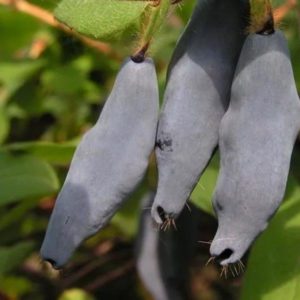
One of the most popular varieties of Russian honeysuckle. Early ripe, versatile in application. The bushes are compact, medium-sized, take up little space on the site. The variety got its name due to the fusiform shape of the berries. The color is black with a blue thick bloom, the skin is strong, the berries do not crack after ripening. Average fruit weight 0.9 g, sweet and sour taste with bitterness.
Honeysuckle Blue spindle bears fruit for 30 years, is resistant to diseases and pests. In the middle zone of the Russian Federation, the harvest is harvested in June, when other berries are in the flowering stage.
Long-fruited
The bushes of the Long-fruited are weak, the shoots are thin, purple in color. The plant is winter-hardy, resistant to shedding. Blue berries are elongated, slightly hilly surface. The peduncle is thin, the skin is of medium density. The berry weighs about 0.8 g, the taste is pleasant, sweet with a refreshing sourness.
To increase yields, other pollinating varieties are planted next to Long-fruited. Berries are suitable for fresh consumption and processing, drying and freezing.
Tomichka
Winter hardy early ripening variety Tomichka unpretentious in cultivation. The bushes are medium-sized, the shoots are thin. The berries are black with a blue waxy bloom, the shape is elongated with a depressed top, the average weight is 0.8 g. The taste is sweet and sour, the pulp is tender and juicy.
Tomichka begins to bear fruit in the fourth year after planting, up to 2 kg of fruits are harvested from the bush. The fruits are used for baby and dietary nutrition, canned and ground with sugar.
Interesting! An easy way to recycle honeysuckle and preserve its health benefits is to puree it. The berries are ground with sugar, put in glass jars and stored in a cool place. Drying is another way to preserve your crop. The berries are laid out in one layer on a baking sheet, put into the oven at a temperature of 60 ° C, stir periodically.
Blue bird
An early ripe high-yielding variety ripens by mid-June. The fruits do not crumble, are rarely damaged by pests, are suitable for transportation and storage. The plant is not tall, the shoots are slightly spreading. Berries are oval, weighing about 1 g, black and blue with a thick waxy bloom. The taste is pleasant, sweet and sour. The yield of the Blue Bird is increased due to the introduction of mineral supplements - ammonium nitrate, nitrogen-containing substances.
The variety is planted on nutrient soils with neutral acidity - otherwise the yield will decrease.
Daughter of a giant
The mid-late variety of the Giant's Daughter honeysuckle is versatile in use. The plant is planted in spacious areas - vigorous bushes require a lot of free space. The berries are drop-shaped, elongated, weight about 2 g. The color is blue-violet with a waxy bloom, the peel is dense. The taste is pleasant, sweet and sour, the aroma is refreshing.
Tasting grade score 4.8 points. The variety is not affected by powdery mildew or white spot, protected from wasps and spider mites. Drought resistance is average, frost resistance is high.
Altair
The bushes are medium-sized, the crown is round. Straight shoots with slight pubescence, oval leaves. Ripening period is average, the harvest is harvested in early or mid-July. The berries are blue-blue, weight about 9 g, elongated shape. A strong waxy coating protects the berries from rot, the crop hangs on the bushes for a long time after ripening, is used for transportation and storage. The pulp is tender, pleasant to the taste, aromatic, sweet and sour.
Taste score 4.4 points. Altair is resistant to low temperatures. Honeysuckle is grown for personal use and sale.
Blue dessert
Medium early variety, harvested at the end of June. The density of the bushes is average, the shoots are brown-red, straight and thin. The shape of the berries is drop-shaped, weight is about 0.8 g. The skin is thin, the taste is sweet, without bitterness.
Blue dessert tasting score 5 points. The variety is not affected by fungal and viral diseases, quickly adapts to the climatic conditions of the region, and is resistant to fruit shedding. The berries are eaten fresh or processed. Jams and honeysuckle preserves are added to muffins, pies, cakes, pancakes.
Interesting! A suitable planting material is two year old seedlings. Before planting, 300 g of lime per 1 sq. m. Liming reduces the acidity of the earth. After that, they dig a hole with a diameter of 60 cm and a depth of 40 cm. It is fertilized with manure, peat, potassium salt and superphosphate.
Zest
Bushes at Zest medium-sized and slightly spreading. The shoots are curved, purple, slightly pubescent. The berries are elongated, weighing about 1.1 g, blue with a bloom.
The taste is sweet, without sourness and bitterness, 4.8 points. The variety is fast-growing, the crop is harvested 2-3 years after planting. One bush annually produces up to 3 kg of tasty and juicy fruits. The cultivar requires pollinators for fruiting. Zest grows quickly in shade or partial shade, undemanding to the composition of the soil.
Early varieties of honeysuckle for central Russia
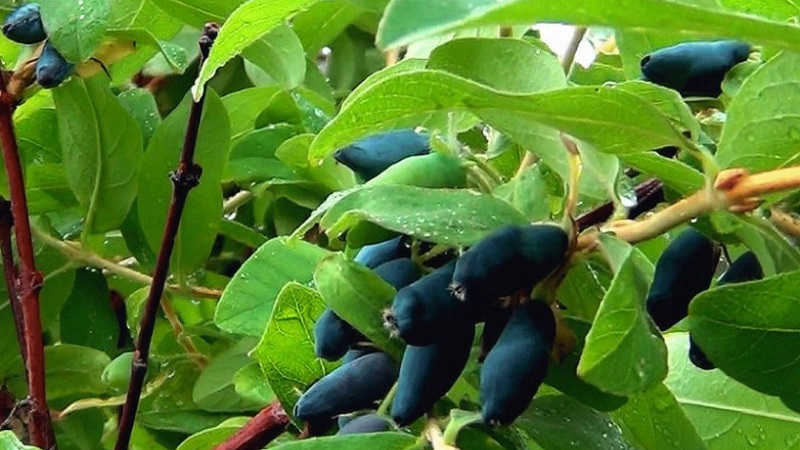
The early harvest of honeysuckle is used for fresh consumption and processing. The berries are harvested at the beginning of June. From early maturing varieties, it is recommended to pay attention to Kasmala. The bushes are compact, medium-sized. The leaves are light green, ovoid, matte. The berries are violet-blue, round, average weight 1.2 g. The skin is thin with a waxy bloom without pubescence. The pulp is sweet and sour, juicy and aromatic.
Tasting assessment of berries - 4.9 points. Casmala is winter-hardy, does not require special skills in cultivation.
Another popular early variety is Minusinskaya Blue. Bushes are medium spreading with straight shoots. The leaves are dark green, the flowers are large. The berries are deep blue in color, weight about 0.8 g, the skin is strong, with a waxy coating. The variety is resistant to drought and insects, fast-growing - the crop is harvested in the third year after planting. One bush gives about 2 kg of aromatic fruits.
Late ripening
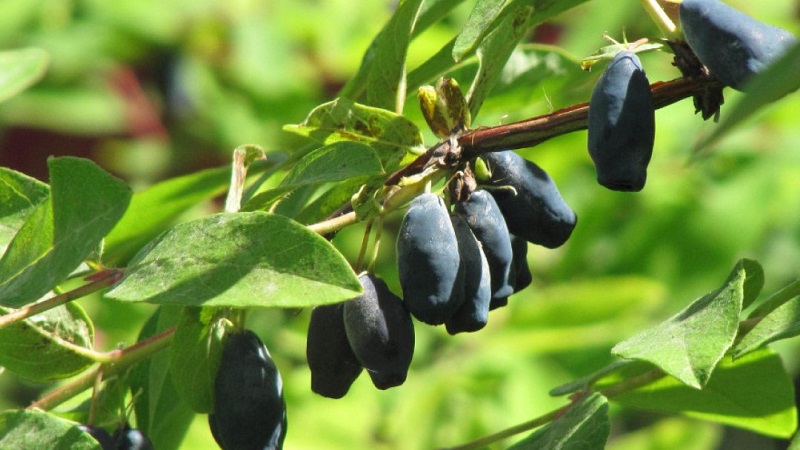
Late honeysuckle ripens in late July - early August. Berries are not only eaten fresh or processed, but also dried, transported, and sold.
Honeysuckle Provincial is distinguished from late varieties. The bushes are weak, the shoots are curved, without pubescence. The berries are large, the average weight of one is 1.9 g. The shape is elongated-oval, the color is dark blue with a thick waxy bloom. Provincial bears fruit for 3-4 years after planting, needs pollinators. The pulp is tender and aromatic, the taste is sweet and sour, without bitterness. Taste score 5 points. The crop is grown for sale: the berries tolerate transportation well.
The late variety Resistant is also noted. Honeysuckle is not affected by powdery mildew and white spot, it is immune to pests. The bushes are vigorous with dull thick shoots. Berries are oval-tuberous, weight about 0.8 g. Color is blue with a waxy bloom. Tasting score 4.2 points, sweet and sour taste with a slight bitterness. Application of Persistent universal honeysuckle.
Other parameters
In addition to the timing of ripening, summer residents pay attention to characteristics such as fruit size, taste, pollination. Some prefer self-fertile varieties, others are more important sweet and harmonious taste.
The largest
The average weight of one berry is 1 g, but some varieties delight summer residents with berries weighing 2 g or more. Such fruits are ideal for fresh consumption, conservation, drying and freezing.
The following varieties are distinguished from large-fruited:
- Yugan. The berry weight reaches 1.8 g, the shape is pitcher-shaped. The color is blue with a gray waxy bloom, the skin is of medium density. The taste is sweet with a pleasant refreshing aroma. The ripening period is average, the purpose is universal, winter hardiness and immunity to diseases are high.
- Bakchar giant... Bushes are vigorous, spreading. Berries are oval, color blue, average weight 1.9 g. The skin is medium thick, with a waxy bloom. The pulp is tender, sweet and sour, without bitterness. Diseases and pests are not terrible for the Giant.
- Atlant. A mid-season dessert variety that is versatile in use. Quickly, the harvest is harvested in the third year. The berry weighs up to 1.5 g, the surface is bumpy, the shape is elongated oval. The taste is sweet and sour, the aroma is delicate. Jam and preserves are made from honeysuckle, fruits are added to ice cream or milkshakes.
Self-pollinated
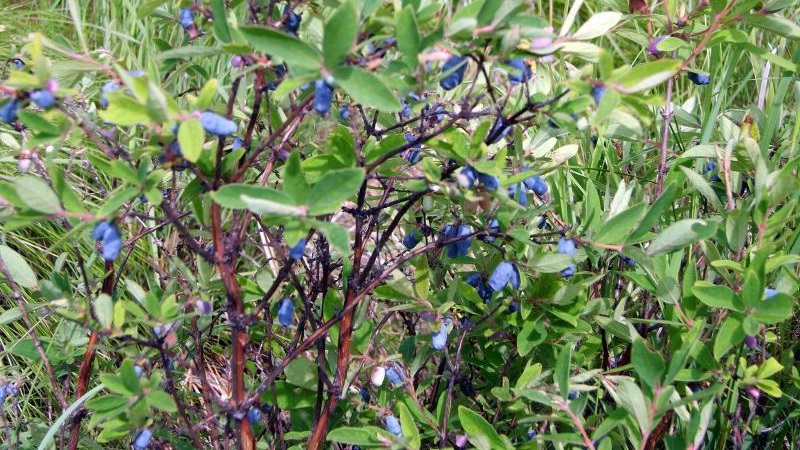
Self-pollinated varieties do not require pollinating insects or other nearby honeysuckle varieties. This makes it easier to care for the plant, does not require an artificial pollination procedure.
Among the self-pollinated varieties are:
- Nymph. The ripening period is medium early, summer residents harvest in mid-June. The bushes are medium-sized, the shoots are thick and straight, there is a slight pubescence. The flowers are white-yellow, medium-sized. Berry weight 0.8 g, fusiform, dark purple color with a blue bloom. The pulp is sweet and juicy, with a rich berry aroma.
- Siberian. The berries are blue-blue, weight 1 g. The taste is pleasant, the tasting score is 4.9 points. There is a waxy coating on the surface, it protects the fruits from rot. Sibiryachka's bush is medium-sized. The variety is resistant to frost, not damaged by wasps and aphids. Suitable for fresh consumption and transportation, unpretentious in cultivation.
The sweetest
The sweet and aromatic pulp will delight every gardener. These berries are good in any form, be it jam or sugar puree.
Fruit taste is harmonious, juicy and delicate:
- Sweetheart. The bushes are weak, the shoots are brown, thick.The shape of the berries is oval, the color is blue, the skin is thick, the weight is about 1 g. The flesh tastes good, the tasting score is 5 points. Sweetheart is slightly affected by powdery mildew and rot, after ripening it does not crumble. Suitable for cultivation in summer cottages and backyards.
- Nightingale. The bushes are medium-sized, early-growing - the gardeners collect the first crop 2-3 years after planting. The berries are blue-blue with a bloom, the shape is elongated, fusiform, the flesh is tender. The taste is sweet, balanced, 4.6 points. The nightingale is suitable for industrial cultivation.
- Lapis lazuli. Mid-season variety, versatile in use. The berries are purple, oblong-oval in shape. Fruit weight 1.4 g, taste sweet and delicate. The skin is thin but firm and protects the honeysuckle from cracking. Also, resistance to low temperatures is distinguished from the advantages of the variety.
Recommendations for choosing a variety
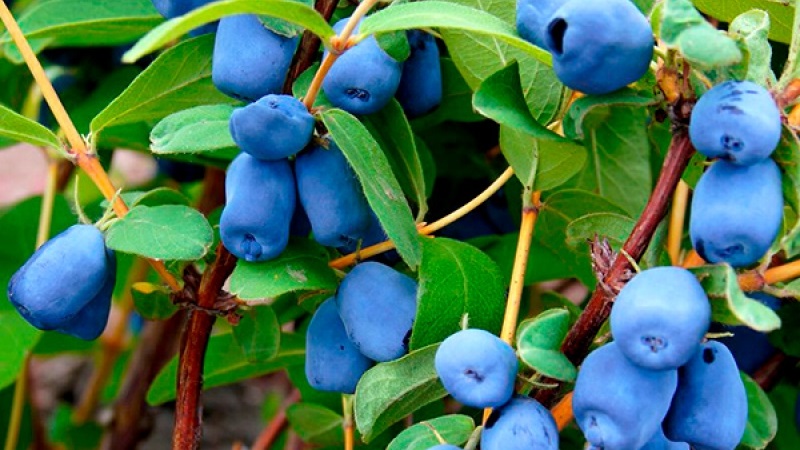
When choosing, take into account the ripening period. Early-ripening varieties are grown in warm regions, late-ripening in cooler regions. It is recommended to pay attention to early maturity - most gardeners prefer varieties that yield in 3-4 years. There is honeysuckle, which bears fruit only for 5-7 years.
It is important to take into account the taste and marketability of the fruit, to study the reviews of other gardeners. For fresh consumption, sweet honeysuckle is grown, the size of the fruit does not matter. For processing, storage or sale, it is recommended to plant large-fruited honeysuckle with resistance to cracking.
Attention! For planting in small areas, compact, slightly spreading bushes are chosen - they take up little space, do not block other plants.
Conclusion
Blue Spindle, Giant's Daughter, Blue Bird are the most popular varieties of edible honeysuckle for planting in central Russia. They are appreciated for their unpretentious cultivation, early maturity, sweet taste, frost resistance. Such honeysuckle rarely gets sick, is not damaged by pests.
Also, from the varieties, the large-fruited honeysuckle Atlant and Yugan, the self-fertile Sibiryachka and Nymph, sweet Lazurite and Nightingale are distinguished. Due to the wax bloom, the berries are stored for a long time, do not lose their taste and marketability.